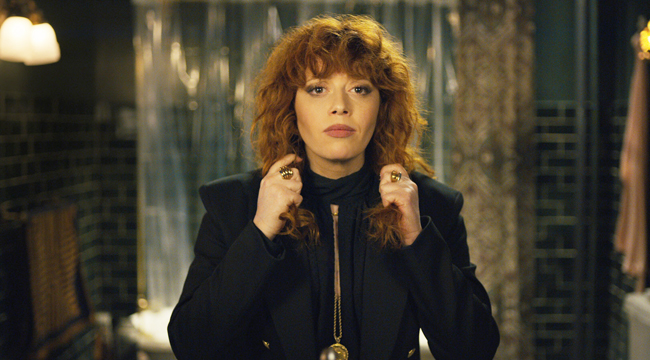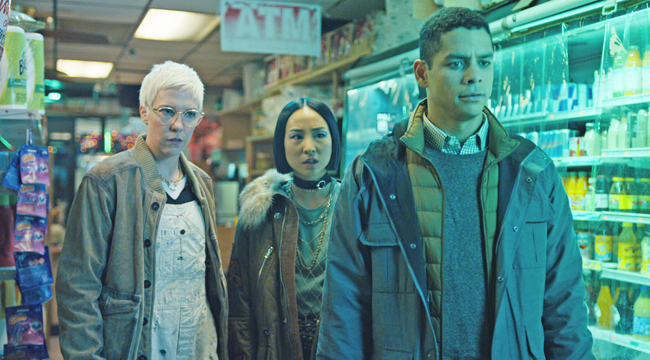
Russian Doll is full of hidden riches. I don’t mean that in an Easter-egg sort of way or even a Bandersnatch, choose-your-own-adventure manner. Yet to describe this Netflix series starring Natasha Lyonne is at once an extremely easy yet impossibly difficult task. It’s a tightly-constructed show that’s sweeping in its scope. It’s a brash and unapologetic monster with a believable soft side, and it’s one of the most compelling original series to debut in awhile. I honestly wouldn’t be surprised to see it land on some year-end lists, but given the sheer volume of TV we’ll see this year, yup, too soon to call. One thing is certain — this is the overdue showcase for Lyonne that anyone who digs her and is familiar with her troubled personal history hoped for but never saw coming.
Even more impressive, Lyonne not only stars but co-created (and co-executive produced and wrote) alongside Amy Poehler and Leslye Headland (Sleeping With Other People). OITNB‘s Nicky Nichols is pretty close to doing it all, man.
Russian Doll benefits from a Groundhog Day-esque framing device, and the protagonist, Lyonne’s Nadia, gets trapped in a loop where she dies, over and over again, and wakes up unharmed. That architecture succeeded in recent films like Happy Death Day and Edge of Tomorrow and will get viewers through the door. Yet once you’re inside — and I planned to watch half of the episodes at once but failed and binged the whole season — the series resembles a Russian nesting doll, as the title suggests. Peeling back each successive doll-within-a-doll (or perhaps rotten layer of the onion) reveals twisted treasures. The outer layers are cloaked with misanthropic humor (like our tough-to-crack Nadia), and from there, the series veers into drama, horror, mischief, and tragedy. It’s difficult to look away from the rapid-fire developments and tonal shifts, but you might be alright with that, as I was.
Netflix is playing this release close to its sleeve in terms of allowing critics to reveal details, and that works to the show’s benefit. So with that in mind, here’s a spoiler-free run-through for why this could be your next great binge.
– With such potential for variety in a single series on the table, the lead role would be a remarkable showcase for any actor, but it’s hard to imagine anyone pulling this off with the punchiness and vulnerability that Lyonne projects as Nadia. Additionally, I was amazed at the different intonations of “aghast” that she could portray every time a cycle reset. You might also wonder: how difficult it would be, really, to relive a birthday bash thrown in your honor for all of eternity? Doesn’t seem too bad. Well, except for the dying part. That sucks. Observers, though, won’t get tired of reliving Nadia’s night, and as she pieces together how this loop reflects upon her life thus far, one understands exactly why Nadia feels such agony. It does, after all, always eventually turn into the worst night of her life.
– Although this is a Lyonne-focused showcase, Nadia shares the spotlight with confused sidekicks who maneuver around her increasingly frenetic and bizarre behavior with each cycle. She begins each night at her party thrown by Maxine (Greta Lee) and Lizzy (Rebecca Henderson), both kinda one-dimensional characters, yet Allen (Charlie Barnett of Chicago Fire) is a kindred soul of sorts to Nadia. Barnett’s performance does a lot to cement the latter half of the season while the series ascends from gimmick-based origins to a higher plane. There are also a few other featured actors who I can’t mention without giving too much away. They add to the breathable, mutable fabric of the series, all the way down to the final moments when the puzzle comes together, and that final, inner “doll” shifts into focus. It’s surreal.

– Nadia’s a through-and-through New Yorker, and she comes by her jadedness honestly. Netflix has warned about revealing the particulars as to how she acquired this affliction, but let’s say that she’s got issues, and until this point, she’s very much handled them well. It’s at the point that one keeps dying that old trauma makes itself known again. The process in discovering why Nadia feels the way she does is, again, part of what makes this an engrossing experience.
– Because Nadia’s a seasoned video-game coder, she holds plentiful wisdom that might have benefited the Bandersnatch characters. Fortunately, that’s the only comparison to be made between the two Netflix projects. Lyonne infuses so much of her own life-earned authenticity into her portrayal that her bits of coding-speak don’t play as gratuitous but, rather, feed the narrative at hand. That is to say, each death-cycle does not result from a “Sugar Puffs or Frosted Flakes?” mindset but to further Nadia’s ultimate cause. She learns much more about herself and those who surround her than she’d ever be able to learn in a singular linear timeline, and when the series begins to dig deep into relativity, well, hold onto your all-black wardrobe.
– Naturally, there are multiple Groundhog Day throwbacks, although Nadia never explicitly mentions the iconic Bill Murray flick despite being otherwise very current on her pop culture. There’s also an updated musical accompaniment-earworm, for her “rebirths” take place to Harry Nilsson’s ridiculously upbeat “Gotta Get Up.” And yes, this contributes to Nadia’s angst, which makes her increasingly furious (and unnerved) after having apparently “survived” yet another death.
– Man, what a writing and co-showrunning debut from Natasha Lyonne. It’s really tempting to speculate about what she’ll do as a followup. God forbid that Netflix orders up a second season of Russian Doll and casts a shadow on this impressive debut. This series that nails the execution of a high-concept with such stunning brutality and humanity. Please don’t ruin a good thing, streaming powers that be.
Netflix’s ‘Russian Doll’ streams on Friday, February 1.






